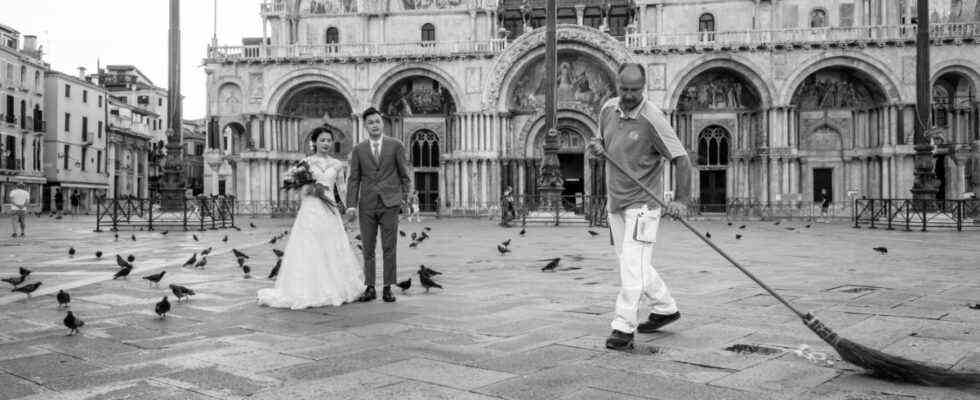Many write postcards from their vacation. Instead, the Austrian photographer Leo Fellinger writes letters on his travels. And addresses it: to yourself. In his autobiographical travel diary “Ich ist der Other” published by Otto-Müller-Verlag, he now undertakes an exciting experiment in order to re-encounter his own travel experiences after years and to be amazed at the “I” that the Once wrote letters. As a simultaneous writer and reader of the letters, Fellinger explores his then and now “I” in his own thoughts and feelings by describing memories of the past. In the book, he combines his stories with monochrome photographs that were taken at the places he visited.
Fellinger takes the reader to sixteen places, all of which have a special beauty and which are preserved by inspiring people. He describes the sad conversation with Guistina, an older coffee house owner in Venice. She reveals to him her view of the former world metropolis overlaid with myths, which, in her opinion, is perishing due to tourism. Fellinger captures the drift and bustle of the lagoon city, which is characterized by the quiet emigration of the inhabitants.
In the calm Tuscan town of Poppi, men linger on a bench in one of the numerous alleys.
(Photo: Leo Fellinger)
From Venice he drives to Sankt Gerold in the Grosses Walsertal, there to the monastery of the same name, where he traces the atmosphere of free spirit, human love and the creative power with which Father Nathanael Wirth once shaped the place. On Sylt, Fellinger experiences the tranquil slowness of the preseason and is fascinated by the rhythm of the sea, the tides. For him, the island exudes a captivating authenticity. He tells of the encounter with the last shrimp fisherman on Sylt, the 76-year-old Paul Walter, who describes his world to him: an old seafarer who goes into raptures when he talks about his life on the cutter.
On the North Sea island of Sylt there are many house roofs that are covered with thatch in the old tradition.
(Photo: Leo Fellinger)
The trip also takes us to the American west coast to San Francisco, whose status as the supposedly most beautiful city in the world is debatable in Fellinger’s opinion, but which is nonetheless full of peculiarities. A city with up to 2000 hours of fog a year, outstanding personalities and dozens of house entrances where the many homeless people sleep when it rains. All travel experiences lead Fellinger to a wiser, if older “I”.
As a reader, you not only feel connected to the author in an almost trustworthy pen friendship, but also immerse yourself in the narrated events and experiences in a miraculous way, as if you were sitting right next to the writer. The stories are more than pure travel experiences. Momentary questions are raised but remain unanswered in the letters. A philosophical bond runs through the book, directing one’s gaze to one’s own existence, existence and the search for meaning. Quoted poems, for example by Juan Ramón Jiménez or Hermann Hesse, broaden the view of the described travel moment and the changing identity of the respective “I”.
The photographs are a valuable addition to the letters. On the one hand, they show full-page scenic shots. For example a man in Venice who sweeps St. Mark’s Square with a brush in the morning while a bride and groom watch him. Other shots have something meditative about them, reveal a vastness – like the sea in southern Sweden that glitters in the sunlight and gently sways to and fro. Sometimes it’s people, photographed unnoticed in everyday life or portrayed directly, sometimes statues and architecture, then again detailed photos of nature. Not all of the scenes and people described in the letters are always shown in the photos, but in any case a stimulating perspective of what has been experienced and observed unfolds.
“I am the other” reveals the special in the everyday, the new in the immortal, the near in the distant through the mixture of letters and photographs. The perpetual, appreciative choice of letters that Fellinger uses in all stories also shows a self-contained, loving conversation between the past and present “I”. The supplementary photographs offer space for readers to recognize hidden stories behind the snapshots and to fill the black and white images with color in the mind’s eye. Fellinger draws places of refuge for searching souls in the midst of a restless world that is incomparable and enchanting. “I am the other” is experience and learning at the same time, which encourages you to embark on a journey to yourself.
Leo Fellinger: I am the other. Or: letters to me. Otto Müller Verlag, Salzburg-Vienna 2021. 207 pages, 49 euros.

